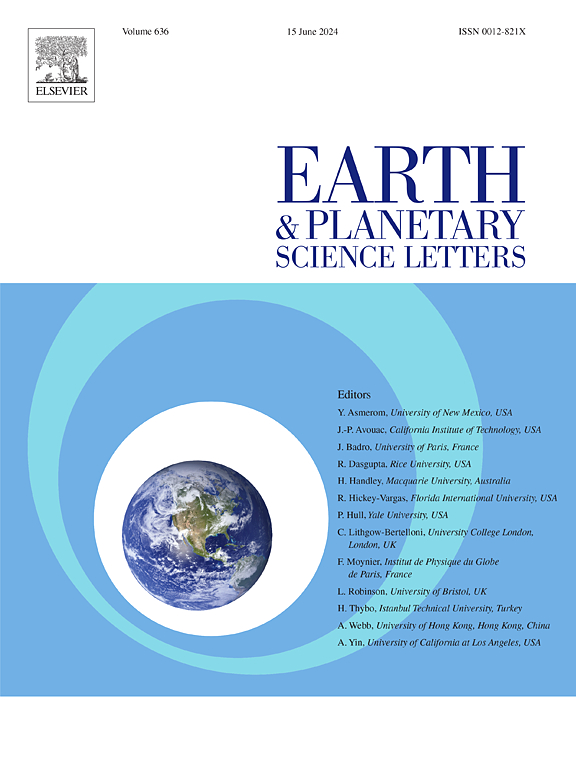魔鬼洞方解石中的水分过剩:平衡分馏和古水分来源的指示
IF 4.8
1区 地球科学
Q1 GEOCHEMISTRY & GEOPHYSICS
引用次数: 0
摘要
古水文学通常以陆地环境碳酸盐档案中的δ18O测量为基础。CaCO3中的三氧同位素(给出17Oexcess = 106 [ln (10-3 δ17O + 1) - 0.528 ln (10-3 δ18O + 1)]最近被证明记录了碳酸盐母水的17Oexcess,从而提供了额外的古水文信息。洞穴中所记录的古雨水过剩可能指示了水分来源位置和蒸发条件的变化。以分馏斜率θ (= ln17α / ln18α)为特征,在快速生长的合成碳酸盐岩和生物成因碳酸盐岩中,以及在一些气相洞穴中,已经确定了水与碳酸盐17o过量之间的联系。在这里,我们使用生长非常缓慢的魔鬼洞乳突方解石来检查平衡时的分异坡度,并评估大盆地(美国)的雨积冰期假设。结果表明,平衡分馏斜率与速生碳酸盐的平衡分馏斜率一致。魔鬼洞古水的过量值在冰期和间冰期极值之间以及在终止期II和终止期IV之间难以区分。这些重建的过量值也与现代魔鬼洞水的过量值相似(45 / meg)。我们将观测到的17o过量解释为在间冰期到达魔鬼洞内陆地点的水分有显著的大陆再循环,但在冰期再循环大大减少。本文章由计算机程序翻译,如有差异,请以英文原文为准。
17Oexcess in Devils Hole calcite: an indicator of equilibrium fractionation and paleo moisture sources
Paleo-hydrology is typically based on measurements of δ18O in carbonate archives of environments on land. Triple oxygen isotopes (given as 17Oexcess = 106 [ln (10–3 δ17O + 1) – 0.528 ln (10–3 δ18O + 1)] in CaCO3 has been recently shown to record 17Oexcess of the carbonate parent water, thus providing additional paleo-hydrology information. Paleo rain-water 17Oexcess, as recorded in speleothems, may be indicative of changes in moisture source location and evaporative conditions. The link between water and carbonate 17Oexcess, as characterized by the fractionation slope θ (= ln17α / ln18α), has been determined in fast growing synthetic and biogenic carbonates, and in a few vadose speleothems. Here, we use the very slow growing mammillary calcite of Devils Hole to examine the fractionation slope at equilibrium, and to assess hypotheses of pluvial glacial periods in the Great Basin (USA). Results suggests that the equilibrium fractionation slope is consistent with that of fast-growing carbonates. 17Oexcess values in Devils Hole paleo water are indistinguishable between glacial and interglacial extremes, as well as through Terminations II and IV. These reconstructed 17Oexcess values are also similar to that of modern Devils Hole water (45 per meg). We interpret the observed 17Oexcess to reflect significant continental recycling of the moisture reaching the inland site of Devils Hole during interglacials, but much reduced recycling during glacials.
求助全文
通过发布文献求助,成功后即可免费获取论文全文。
去求助
来源期刊

Earth and Planetary Science Letters
地学-地球化学与地球物理
CiteScore
10.30
自引率
5.70%
发文量
475
审稿时长
2.8 months
期刊介绍:
Earth and Planetary Science Letters (EPSL) is a leading journal for researchers across the entire Earth and planetary sciences community. It publishes concise, exciting, high-impact articles ("Letters") of broad interest. Its focus is on physical and chemical processes, the evolution and general properties of the Earth and planets - from their deep interiors to their atmospheres. EPSL also includes a Frontiers section, featuring invited high-profile synthesis articles by leading experts on timely topics to bring cutting-edge research to the wider community.
 求助内容:
求助内容: 应助结果提醒方式:
应助结果提醒方式:


